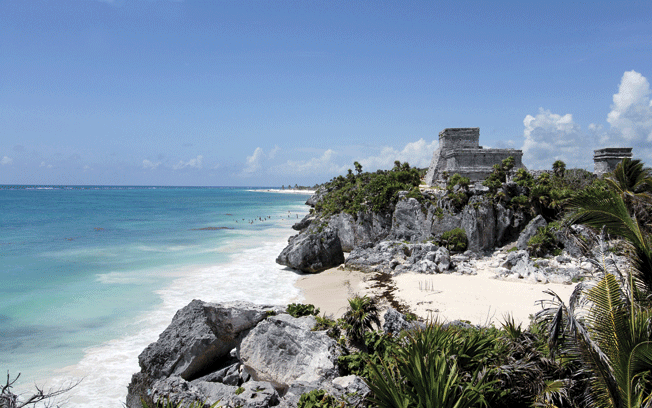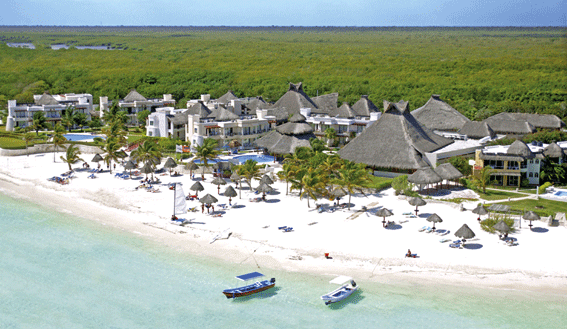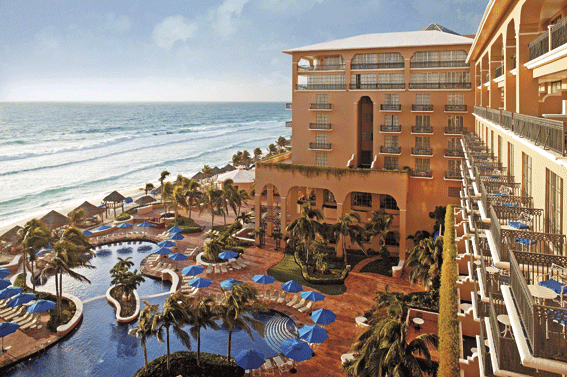
Travel
Yucatan
A Skeptic’s Guide to
Mexico’s Caribbean Coast

First impressions matter, and my initial glimpses of Cancun and the Mexican coastline
stretching south of it, known as the Riviera Maya, were dismaying.
“Why would anyone come here?” I wondered as our van sped across the flat mangrove swamp
from Cancun’s airport. A few miles ahead I could see a wall of mega-resorts and
construction cranes hugging a barrier island 22 miles long and a few hundred yards wide:
Miami Beach meets Las Vegas, minus the Cuban coffee.
By: Tom Passavant
Three weeks later I had undergone considerable attitude adjustment. Having explored Cancun and 80 miles of Caribbean coastline, including Playa del Carmen and Tulum, and later the islands of Cozumel and Isla Mujeres, I had lost track of the day and time.
Cancun: Mexico’s Couldn’t-Be-Easier Resort City
The answer to why 4 million people a year visit Cancun begins with the fact that this is Mexico with a security blanket. Dollars are universally accepted and everyone speaks English. The weather is hot year-round, the beaches are bleached-blonde coral sand, and every imaginable sport on, under and above the sea is a few pesos away.
Beyond those obvious lures, we made some highly enjoyable discoveries. We had a memorable time swimming with dolphins at a facility called Delphinus. And we enjoyed a taste, in more ways than one, of genuine Mexican life just across the causeway that connects Cancun to the mainland, in what’s referred to as Cancun city.
Thirty-eight years ago Cancun was inhabited by a handful of fishermen. Today this skinny, hurricane-prone sand spit, which is shaped like an elbow, has an amazing 28,000 hotel rooms, 450 restaurants and 13 golf courses.
A lot of the scenery was rearranged in October 2005 when Hurricane Wilma dumped 23 inches of rain and laid waste to the beach and numerous resorts (virtually all of which are built right atop the dunes). When Hurricane Dean roared through in August 2007, it devastated the coastline to the south but had less of an effect on Cancun. The silver lining was that many resorts took the opportunity to upgrade their facilities, and by now you’d be hard-pressed to see much damage. The beaches, though, were slower to recover, and visitors might still notice exposed rocks and narrow strands outside some of the properties.
The first question everyone asks is where they should stay. Cancun has over 150 hotels, but most of them fit into familiar categories. There are all-inclusives (Club Med, Dreams), upscale brand names (Ritz-Carlton, Meridien, JW Marriott) and a middle ground of large hotels where the price-value equation seems especially sweet (Presidente InterContinental, CasaMagna Marriott).
Generally speaking, lodging prices are considerably lower in Cancun and environs than in, say, the Caribbean or Hawaii -- another reason for the area’s enormous popularity. We spent our first few days at an all-inclusive resort, the 1,700-room Grand Oasis Cancun, and ended up both liking it (nice rooms, more-than-decent food) and respecting it (how do you train a staff that size to deliver such savvy service?). Our only regret was that we fell asleep before the legendary “foam party” in the disco, thus missing out on having several feet of suds pumped on us.
We also enjoyed the CasaMagna Marriott Cancun Resort, where rooms start around $249--much less than at the adjacent JW Marriott -- and there’s an appealing Latin vibe. Their Argentine steakhouse, called La Capilla, was terrific, too.
Most of the major hotels are strung out down the long forearm of beach. Right at the elbow’s joint is a nexus of factory-size shopping, dining and entertainment complexes. Alas, the glittery shopping malls were like Potemkin villages: alluring on the outside, but lifeless inside. On the other hand, the neighborhood is home to Delphinus, a “dolphin interaction program” where we spent 45 enjoyable minutes cavorting in the water with these remarkable creatures.
While a Cancun vacation can proceed by rote (beach, lunch, beach, dinner, club, sleep, repeat), we did make a few useful discoveries that both surprised and pleased us. First, use the buses. They run every few minutes, getting you around in a hurry for about 60 cents. The local nightlife and even downtown Cancun, on the mainland and connected via causeway, are easily accessible. (Cabs, though, are expensive.)
A second happy surprise was Cancun city. It has outdoor dining galore and some lively streets, especially around the Parque las Palapas. Have a drink in the verdant courtyard of the restaurant La Habichuela, then head a few doors down to Labna for traditional Yucatecan dishes like lime soup and roast pork with sour orange sauce.
Riviera Maya: Nature, History and Euro Style
“Welcome to Playa del Carmen, United States,” said the cab driver as we unloaded our bags outside a Burger King on Playa’s main drag. Talk about first impressions. This stretch of Fifth Avenue was wall-to-wall T-shirt shops, hawkers selling snorkeling excursions, and cruise ship escapees, red-faced from too much tequila and sunshine.
The Riviera Maya, which encompasses everything between Cancun and Tulum, gets some 3 million visitors a year. It has most of the area’s not-to-be-missed natural and cultural attractions, including the Sian Ka’an Biosphere Reserve, the Mayan ruins of Coba and Tulum, Xel-Ha water park, and several places where you can descend into cenotes, natural sinkholes that are filled with water.
Nature aside, the 30 miles or so we’d just covered was one uninterrupted construction zone. Carretera 307, as the road is formally designated, was lined with resort entryways posing as triumphal arches made of stone, wood or marble. Sometimes, off in the distance, we could glimpse the top floors of an actual resort. Options range from Eurocentric all-inclusives to chic hideaways.
Upscale brands, such as the new Mandarin Oriental, are the latest arrivals. At Mayakoba, a 580-acre development, the players include Fairmont, Rosewood, Viceroy and Banyan Tree. Not all were open yet during our stay, but you won’t be suffering at the Fairmont, where the rooms, the food and the beach are all world-class. Another favorite was Azul Beach Hotel, less than 30 minutes from the Cancun airport. This reasonably priced, quietly tasteful 97-room all-inclusive comes with a nice beach, a sexy spa and excellent food.
Return visitors tend to be surprised at the exponential growth that has engulfed Playa del Carmen. Today, as one billboard proclaimed, it’s the Style Capital of the Riviera Maya. Playa’s long beachfront may be dominated by all-inclusives, but the upper reaches of Fifth Avenue, two blocks inland, are charming, if not even vaguely Mexican. This neighborhood is referred to as “Little Italy,” as Italians own many of the buildings, including condos on the upper floors and, at street level, cafes and restaurants with hissing espresso machines and fresh pasta drying on the tables.
We stayed at the 10-room Hotel Lunata, an oasis with a garden courtyard. Since it was on Fifth Avenue, not the beach, we paid about $7 per person each day to hang out at the Kool Beach Club, with chaises and umbrellas, a freshwater pool and tasty lunches of gazpacho and fresh shrimp.
Early one morning we set out on an all-day adventure with a company called Alltournative (alltournative.com). Their Mayan Encounter included a tour of the Coba ruins by bicycle, a zip-line ride across a jungle lagoon, lunch at a Mayan village in the middle of nowhere and a thrilling 30-foot rappel down into a cenote, where we swam in the clear fresh water, the only light coming from the eight-foot-wide hole up top.
In Tulum, 30 miles south, the Mayan ruins are perched on a bluff above the Caribbean. You can stroll around the well-manicured grounds, imagining how the Spanish sailors must have felt when, in 1518, they first spotted Tulum’s then brightly painted castle, crowned by a temple, gleaming from the shore.
Today the town of Tulum itself is not much more than a wide spot on the highway, and the real tourist action is about three miles east. Strung out along several miles of the most jaw-dropping beach this side of Thailand are dozens of casual inns, hippie fantasias with vegetarian restaurants and bohemian chic. Yoga is practically mandatory here, electricity is from generators and mosquito nets are not just for atmosphere.